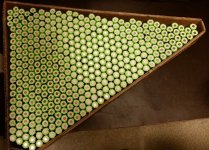LikeToRideMyBike said:Hey guys, I've got a problem. I just hooked up my BMS. When I reached a full charge some lights came on where the balancing cables went in. It was a little warm while these lights were on. It was strange. I don't know, maybe that was normal. But overnight it lost charge from 67.2 volts down to 66.6 volts. That's definitely not normal. What is going on? Do I need to disconnect this BMS and get a new one? I scared that it's going to ruin my brand new Samsung 25r cells. What do you think?
Here is the link to the BMS I used: http://www.aliexpress.com/item/16S-Li-ion-Lipo-Batteries-Protection-Board-BMS-System-60V-67-2V-50A-Continuous-Discharge-Current/32263328170.html
thanks all
Should be normal, the BMS balances the cells to the lowest cell, so it discharges all the other higher cells and will lower your pack voltage. This discharging will cause heat.
If all your cells are balanced the voltage shouldn't drop anymore and nothing should feel warm. If the voltage continues to drop then you have problems.


